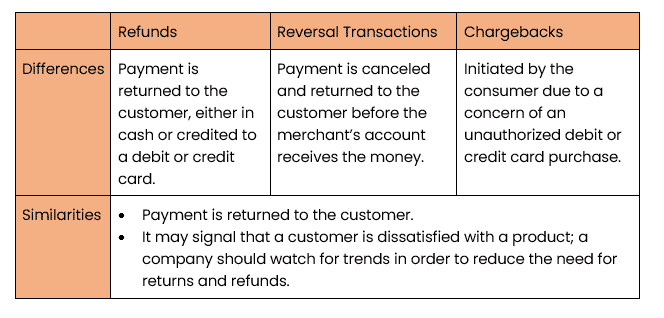Payment Reversals: Refund, Chargeback, & Reversal Transaction

Efficiently managing product returns is only part of the returns journey. Whether you are a B2B, B2C or hybrid enterprise, taking care of the customer throughout the return process is essential for maintaining loyalty and trust.
For the customer, one of the most important questions when making a return is typically: When will I get my money back? This article will help you understand the differences between refunds, chargebacks and reversal transactions.
What is a Refund?
A refund is when a seller pays back the money that a customer spent on an item. Perhaps the item was broken, didn’t meet quality standards, or the customer simply changed their mind. In the end, the sum of money is returned.
Are Refunds Bad for Business?
No business wants to refund customers because that means its product wasn’t up to par. It also means extra administrative work and an impact on profitability. But refunds are inevitable in nearly every type of business, and so the goal should be to reduce the impact of that refund to your bottom line.
How Long Does a Refund Take?
Customers expect a refund as soon as possible. But from a business perspective, a bit of due diligence may be required: Most organizations will issue a refund as soon as the returned product is received, is verified to be in an acceptable condition, and the original purchase is verified.
How does an RMS Speed up Returns?
A returns management system (RMS) can help speed up product returns and customer refunds – and create a more positive customer experience.
When a customer initiates a return, the RMS can trigger a credit or refund at any point in the returns process, giving companies added flexibility. Think of a return as a chance to engage with your customer: The faster the return is processed and the faster the customer is credited, the happier and more loyal they are likely to be.
An RMS also enables companies to set different rules for different customers, such as crediting the best customers right away while holding refunds of other customers until the purchase has been inspected and verified.
Who Initiates a Refund Request?
If your company is using a returns management system (RMS) like ReverseLogix, the refund request is typically made by the customer when the return materials authorization (RMA) is made. More and more often, this is done online through a customer portal or through a mobile app.
Common Reasons for Refunds
The reasons for a refund request vary widely. In the B2B world, perhaps a component was ordered in the wrong size. Perhaps an item arrived damaged. In these refund examples, the customer would request their money back.
In the B2C world, a recent study found that 58% of consumers intentionally buy more goods online than they intend to keep. In the apparel industry, this often takes the form of “bracketing:” When a customer orders several sizes or colors with the intention of returning (and requesting a refund for) the items they don’t want.
How to Reduce Refund Requests
If your business is facing too many refund requests, then a returns management system can help. In other words, use the RMS data analytics and insights into reason codes to determine tactics for stopping returns before they happen in the first place. You get happier customers, lower costs to your business, and less time spent on returns management.
- If quality issues are driving returns: Check with your suppliers or manufacturers to ensure materials or processes haven’t changed.
- If sizing is a problem: Due to the high volume of returns in the apparel industry, more retailers are offering virtual dressing rooms or better product descriptions to help customers find the right fit, the first time.
- Verify that the purchase and return are legitimate: An RMS can help you track order activity and catch fake returns, identify those abusing the returns policy, and reduce overall returns volume.
What is a Reversal Transaction?
A reversal transaction is when a customer has paid for a product, but the money hasn’t yet been received by the merchant’s account. During this time, the customer wants to cancel the transaction (perhaps they realized they bought the wrong item, or quickly changed their mind).
At this stage, the charge is reversed in the midst of being processed.
What is a Chargeback?
A chargeback is simply a payment amount that’s returned back to a debit or credit card. It is usually initiated by the consumer, and can happen when…
- A credit card transaction is disputed by the customer (the disputed funds may be held from the business until the credit card issuer makes a decision)
- A fraudulent or unauthorized purchase is made with a card
Why Chargebacks are Bad for Businesses
Chargebacks can impact a business because the credit card company reimburses the buyer in full but debits the business’ account. In addition, the payment processor may charge a fee or apply other penalties to the business.
How to Combat Chargebacks
There are a few things businesses can do to lessen the risk of chargebacks, all of which are supported by a returns management system. With an RMS, you can…
- Verify order information regarding where a product was sold, registered and its condition
- Provide tracking visibility so a business can verify when a product was received
- Empower your team with the right tools to research and respond to disputes more quickly
- Validate that the purchase was authentic
This insight and visibility into product returns can give your company a paper trail or proof points during a dispute.
How should a Business Handle Warranties?
Refund requests for products that are under warranty will require extra scrutiny and documentation. An RMS can keep customers updated on warranty validation steps to reduce frustration or questions about refunds.
The ReverseLogix RMS enables you to easily manage customer registrations, coordinate returns, and seamlessly manage in-warranty and out-of-warranty repairs in a single platform.
What Are the Differences between a Refund, a Reversal Transaction, and a Chargeback?
Refunds, reversal transactions and chargebacks are inevitable in most industries, yet they open up a company to risk. Understanding the differences between them can help you select returns management technology that will more accurately track returns and purchases, validate return requests, and give you more data insights into which products are returned and the reasons for the return.

